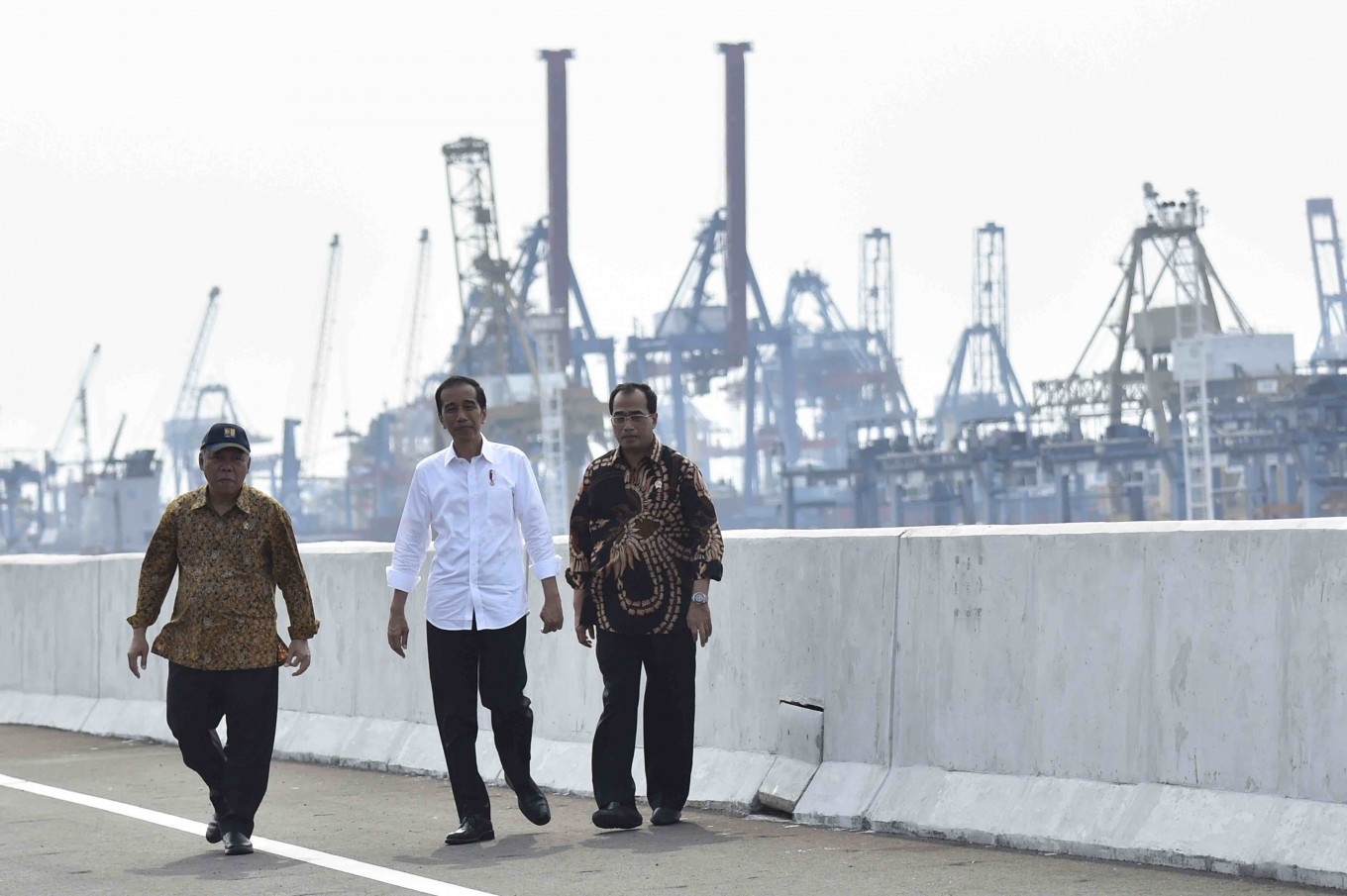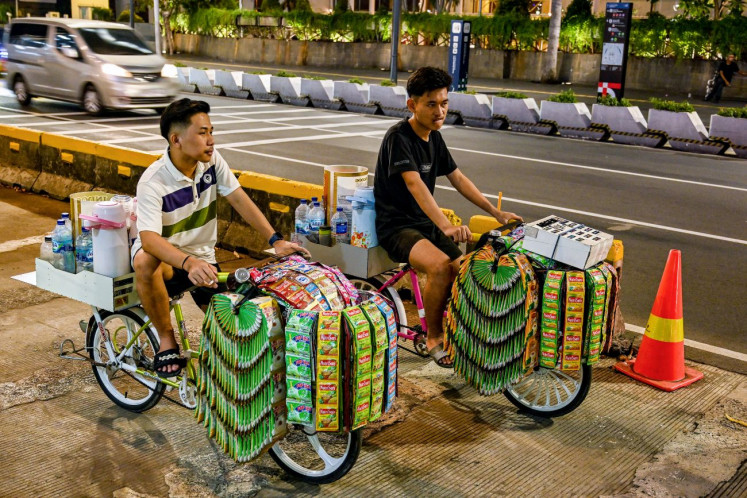Popular Reads
Top Results
Can't find what you're looking for?
View all search resultsPopular Reads
Top Results
Can't find what you're looking for?
View all search resultsHow infrastructure development boosts growth
An independent report titled “The Impact of Indonesia’s Infrastructure Delivery” finds that, as of December 2017, about 286 projects were under construction or have been completed with a total combined value of $103.44 billion.
Change text size
Gift Premium Articles
to Anyone
T
he government’s efforts over the past three years to deliver infrastructure in much more comprehensive ways have drawn acclaim for being timely and much needed. Nevertheless, some critics have painted these projects as politically motivated and a grandstanding campaign. Understandably, in view of the presidential elections scheduled for April 2019, many detractors tend to look at government policies entirely through the prism of politics, irrespective of what the objective of a government program is.
When the administration of President Joko “Jokowi” Widodo came to power in October 2014, it released a nation-building manifesto that had nine components, aptly called Nawacita (Nine Goals). The program prioritizes a reduction of logistics costs and focuses on improved connectivity via a series of infrastructure projects involving highways, railways, seaports, airports and power generation. Nawacita also emphasizes a reduction of poverty and inequality via programs to improve education and health services and issue land titles to millions of farmers and smallholders.
The Jokowi administration’s infrastructure program for the 2014-2019 period amounts to US$342 billion in estimated investment, including the nationwide electrification program. The billion-dollar questions are, of course, how much of this will actually be constructed and what impact will it have on the economy and reducing poverty.
A recent report published by Tusk Advisory, a regional strategic advisory firm specializing in infrastructure, answers these very questions and more. The primary authors of this report are Dr. Nicholas Morris, an Oxford-trained veteran economist, and Raj Kannan, an infrastructure delivery specialist, both experts with many years of experience working in Indonesia and the region. The other authors of the report are Luhut Sibarani and Astrid Handari.
This independent report titled “The Impact of Indonesia’s Infrastructure Delivery” catalogues all of the under-construction and completed projects since early 2015 and finds that, as of December 2017, about 286 projects were under construction or have been completed with a total combined value of $103.44 billion. These projects span energy, roads, railways, seaports, airports, water and sewerage systems and broadband cabling. The number and value of projects under construction is unprecedented, and it comes on the back of key government reforms. This report presents empirical evidence on the impact of the government’s infrastructure capital expenditure on economic growth, as well as the resulting reduction in poverty. Their econometric analysis uses a benchmark of 32 developing and emerging economies, from the World Development Indicators database of The World Bank, for the period of 1990 to 2016.
The Tusk Advisory economists describe the virtuous cycle generated by the infrastructure development: Improving connectivity between the rural and urban areas and between the major islands, reducing logistics (and thereby distribution) costs, enhancing the domestic market integration and improving the overall competitiveness of the economy, thereby attracting direct investment.
The report estimates that, as a result of the completion of current projects by the target date of 2019/2020, the country’s GDP growth rate will increase to 7.2 percent in 2023. If the government then achieves at least half of the remaining programs, another $120 billion, during the years 2020 to 2023, the report estimates that the GDP growth rate in 2030 will exceed 9 percent.
The report also forecasts that, by 2030, as a direct causation of the estimated GDP growth, the nation’s poverty rate will drop from around 11 percent now to 8 percent, thus delivering not only a much-needed boost to the economic growth of the country but also reducing poverty at the same time. The report shows that these GDP growth estimates are also consistent with growth spurts experienced by other countries in the region that had invested heavily in their infrastructure, and indeed the past experience in Indonesia during the early 90s produced similar results.
These are indeed encouraging numbers but, as highlighted in the report, the achievement of these GDP growth rates is highly dependent on the government’s ability to complete the projects that are currently under construction. It is common knowledge that this unprecedented level of infrastructure delivery has been on the back of the government assigning and relying on the strength of state-owned construction companies. Some of these construction companies are cash-strapped and — encouragingly — are exploring new avenues to continue financing these projects.
To its credit, the government has been on the front foot to encourage and facilitate the creation of these new financing instruments, and the recent successful listing of rupiah-denominated “Komodo Bonds” at the London Stock Exchange by two Indonesian infrastructure giants stand testimony to this proactive approach. But there needs to be more concerted efforts to introduce innovative financing schemes that do not beggar the future. While these future revenue-based securities are a good start, they are indeed ultimately government debt, as the issuers are state-owned enterprises (SOEs).
This is where the private sector’s financial and managerial capabilities should be harnessed to support the country’s nation-building plans. While the SOEs are certainly capable, their capacity to continue to issue debt instruments is limited, and therefore the private sector needs to be encouraged to play its rightful role. In encouraging the private sector, the government also appears to be ahead of the curve — it is currently finalizing a regulatory framework to enable raising of fresh capital from the private sector via monetizing some of the key government assets without selling these assets and without borrowing on these assets.
These asset monetizing or asset recycling schemes are the brainchild of the Office of the Coordinating Economic Minister, and they are called Limited Concession Schemes (LCS). Under an LCS, the government will invite the private sector to compete for the expansion, operation and maintenance of selected assets for an agreed concession period of, say, 20 to 25 years.
A good example would be Soekarno Hatta International Airport, which is expected to require more than $5 billion in capital expansion over the next 10 years to cope with ever-increasing passenger traffic. Instead of the state-owned airport operator spending this money on one airport, under the LCS, the private sector will be invited to take over the capital expansion at their cost and recoup their investments from the operating revenue of the airport during the 20-year concession period.
Most importantly, under the LCS, the private sector will provide either upfront cash payments as concession fees to the government, which it can use to build other airports (and share with the existing airport operators) or it can agree to ongoing revenue sharing during the concession period. For Indonesia, enabling and unlocking private sector participation in infrastructure delivery is one of the key reforms needed to achieve a more lasting impact on economic growth and poverty reduction. While the government still has a long way to go to fix its funding problems, it appears the thought leaders are on the right path of harnessing not only SOEs but also the private sector.
***
The writer is a senior editor of The Jakarta Post.











